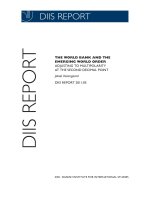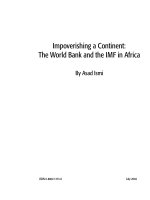gg38 world bank, reshaping the future (2005) yyepg lotb
Bạn đang xem bản rút gọn của tài liệu. Xem và tải ngay bản đầy đủ của tài liệu tại đây (1.07 MB, 118 trang )
RESHAPING
THE FUTURE
Education
and
Postconflict
Reconstruction
Reshaping the FutureReshaping the
Future
Education and
Postconflict
Reconstruction
THE WORLD BANK
Washington, D.C.
© 2005 The International Bank for Reconstruction and Development/
The World Bank
1818 H Street, NW
Washington, DC 20433
Telephone 202-473-1000
Internet www.worldbank.org
E-mail
All rights reserved.
1 2 3 4 07 06 05 04
The findings, interpretations, and conclusions expressed herein are those of the
authors and do not necessarily reflect the views of the Board of Executive Directors
of the World Bank or the governments they represent.
The World Bank does not guarantee the accuracy of the data included in this
work. The boundaries, colors, denominations, and other information shown on
any map in this work do not imply any judgment on the part of the World Bank
concerning the legal status of any territory or the endorsement or acceptance of
such boundaries.
Rights and Permissions
The material in this work is copyrighted. Copying and/or transmitting portions or
all of this work without permission may be a violation of applicable law. The
World Bank encourages dissemination of its work and will normally grant
permission promptly.
For permission to photocopy or reprint any part of this work, please send a
request with complete information to the Copyright Clearance Center, Inc., 222
Rosewood Drive, Danvers, MA 01923, USA, telephone 978-750-8400, fax 978-
750-4470, www.copyright.com.
All other queries on rights and licenses, including subsidiary rights, should be
addressed to the Office of the Publisher, World Bank, 1818 H Street NW,
Washington, DC 20433, USA, fax 202-522-2422, e-mail
ISBN 0-8213-5959-2
Photo credit: Ray Witlin, World Bank.
Library of Congress cataloging-in-publication data has been applied for.
Contents
Acknowledgments ix
Foreword xi
Acronyms and Abbreviations xiii
Executive Summary xv
1. Introduction 1
Relationship between Conflict and Poverty 2
Relationship between Education and Conflict 2
The Present Study 3
2. Conflict, Poverty, and Education 7
Factors Affecting Conflict Risk 8
Characteristics of Resilience to Conflict 11
3. The Impact of Conflict on Education 13
Destructive Effects of Conflict 16
Surprising Resilience of Educational Systems 21
Postconflict Reconstruction Conundrum 25
4. Preliminary Lessons 29
Key Factors 29
Key Principles 30
Conflict Analysis 32
Operating Environment 34
v
Sequencing Interventions 35
Leveraging Interim Arrangements and
Transitional Mechanisms 36
Prioritizing within a System-wide Approach 37
Building on Existing Initiatives 37
Demonstrating Early and Visible Impact 38
Encouraging Community Involvement 38
Early Initiation of Technical and Capacity-building Work 39
Building Effective Partnerships 39
5. Promising Directions in System Reconstruction 41
Sector Assessment 41
Challenges for Decentralization 42
Education Access 46
Quality Improvement 47
Qualified Teachers 49
Curriculum Issues 52
Financing and Governance 54
Specific Postconflict Challenges 57
6. Neglected Issues 63
Sectoral Imbalance 63
Challenges of Interagency Coordination 64
Refugees and Internally Displaced Populations 66
Youth and Adult Education 68
Interlinked Initiatives 71
The Role of Private Education 71
7. A Role for the World Bank 75
Deployment of Bank Resources 76
Neglected Areas of Youth and Secondary Education 81
8. Concluding Comments 85
Index 87
boxes
4.1 Sinclair’s Principles of Emergency Education 31
5.1. Summary of Key Lessons from Central America 43
vi contents
contents vii
6.1 Strategies that Address Youth Unemployment
and Exclusion 72
figures
3.1 Burundi: Gross Enrollment Rate, 1988-1999 17
3.2 Burundi: Net Enrollment Rate, 1990-2000 21
3.3 Gross Enrollment Rates and Conflict 22
3.4 Enrollment Trends in Rwanda, 1970-2001 24
3.5 Enrollment Trends in Timor Leste, 1976-2001 24
4.1 The Education Reconstruction Continuum 35
5.1 Timor Leste Enrollment Poverty Gap, 2001 47
5.2 Education Expenditure as Percentage of
Gross Domestic Product 55
6.1. United Nations Coordination Mechanisms Affecting
Education Reconstruction 65
tables
3.1. Refugee Populations above 200,000 Located within
Same Region as Country of Origin 15
3.2. Schools Requiring Repair or Reconstruction
after Conflict 17
7.1 Analysis of World Bank Loan and Grant Education
Expenditure (Completed and Active) in 21
Conflict-Affected Countries, 1994–2002 77
Acknowledgments
This study was undertaken by a small team in the Human Develop-
ment Network Education Hub (HDNED) under the leadership of
Peter Buckland, Senior Education Specialist, who would like to ac-
knowledge the important contribution of Raymond Muhula, Research
Assistant. His relentless pursuit of data in a very challenging context
provided important basic information for this study. The work would
not have been undertaken without the support of HDNED. Sector Di-
rector, Ruth Kagia, and the steadfast and expert guidance and encour-
agement of the Education Sector Manager, Jamil Salmi. The work of
the team was supported by regular comments and inputs from a wide
range of people in the Bank, most of whom were members of a small
community of practice groups established for the purpose. Key among
them were Ian Bannon, Ernesto Cuadra, Peter Colenso, Tia Duer,
Kuzvinetsa Dzvimbo, Vince Greaney, Rick Hopper, Maureen Lewis,
Saida Mamedova, Juan Moreno, Susan Opper, Bob Prouty, Francis
Steier, Gary Theisen, Chris Thomas, Eluned Roberts-Schweitzer, and
Jim Stevens. Also acknowledged here is the valuable contribution of
the external reviewers, Nat Colletta and Marc Sommers. The work of
the team was ably supported throughout by colleagues in the Educa-
tion Advisory Service and by Inosha Wickramasekera and Mado
Ndau, who provided invaluable help with logistical arrangements.
Foreword
Violent conflict, with its bloody assault on people and institutions and
its invariably debilitating aftermath, is the epitome of “development in
reverse.” Sadly, as the many case studies in this book and other publi-
cations amply demonstrate, conflict and poverty are closely interwo-
ven. Conflict blunts, and subsequently unravels, years of hard-won
economic and social development. Recent research also shows us that
development patterns—which worsen inequalities, deepen poverty, or
slash at the ties that bind societies together—can themselves con-
tribute to the likelihood of conflict and its haunting recurrence.
One of the most devastating impacts of violent conflict is the dam-
age it inflicts on education systems and the children and students they
serve. More than two million children have died as a direct result of
armed conflict over the last decade. At least six million children have
been seriously injured or permanently disabled. Long after the guns
stop firing, the lives of students and teachers continue to be imperiled
by the discarded litter of war: landmines, unexploded shells, and the
proliferation of assault rifles, guns, and ammunition. Some schools in
Cambodia and Angola will be closed for years to come because they sit
in the middle of a minefield, and whole villages have simply become
“no-go” areas.
Teachers often bear a heavy cost in times of conflict. In Rwanda
more than two-thirds of the teachers in primary and secondary schools
were killed or fled. In Cambodia the carnage was even greater, leaving
the system virtually without trained or experienced teachers. In Timor
Leste, the impact on teacher numbers of that relatively short conflict
was uneven: in primary schools, 80 percent of the teachers were Tim-
orese and remained, while almost all secondary school teachers were
Indonesian. The failure of the Indonesian teachers to return left Timor
xii foreword
Leste with almost no trained or qualified personnel for its secondary
system and no access to tertiary education.
These effects ravage the education process. They also constitute a
formidable roadblock for the efforts of poor countries to achieve the
Education for All (EFA) Millennium Development Goals, especially
the 2015 targets of universal primary school completion and gender
equality in primary and secondary education. The central message of
this book is that education has a key role in both preventing conflict
and rebuilding fractured postconflict societies.
Education commands high priority in both the initial humanitarian
phase of national and international response and in the postconflict re-
building phase. Every education system has the potential to either ag-
gravate the conditions that lead to violent conflict or to heal them. The
unavoidable conclusion must be that ignoring education, or postpon-
ing it, is not an option.
Even when it is part of a humanitarian response, education is a de-
velopment activity and must be undertaken with a developmental per-
spective if it is to contribute to reversing the damage and to building
resilience to prevent further violent conflict.
Yet schools and education systems, whether they were a contribu-
tory factor to a conflict, are invariably debilitated by conflict. They are
left weakened, damaged, and underresourced at precisely the time
when communities, governments, and international agencies need
them to help rebuild and transform themselves and the societies they
serve. This twin mandate of reform and reconstruction offers both sig-
nificant opportunities and enormous challenges to societies emerging
from conflict.
The outpouring of analysis, publications, and research projects in
this field in the past two years suggests that there is now strong recog-
nition of the importance of early investment in education as a prereq-
uisite for successful postconflict reconstruction.
Jean-Louis Sarbib
Senior Vice President
Human Development Network
World Bank
Jamil Salmi
Acting Sector Director
Department of Education
Human Development Network
World Bank
xiii
Acronyms and Abbreviations
ADB Asian Development Bank
CAF Conflict Analysis Framework
CIDA Canadian International Development Agency
CSO Civil society organization
EDUCA Education with Community Participation Program
EFA Education for All
EMIS Education Management Information Systems
EQUIP Education Quality Improvement Project
GDP Gross Domestic Product
GER Gross Enrollment Rate
GoSL Government of Sri Lanka
HPIC Heavily Indebted Poor Countries
IBE International Bureau for Education
IDA International Development Association
LICUS Low Income Countries Under Stress
LTTE Liberation Tigers of Tamil Eelam
NGO Nongovernmental organization
NATO North Atlantic Treaty Organization
MDG Millennium Development Goals
MPLA Popular Movement for the Liberation of Angola
PNA Preliminary Needs Assessment
PRSP Poverty Reduction Strategy Paper
REBEP Rehabilitation of Basic Education Project
TSS Transportation Support Strategies
UPC Universal Primary Completion
UNAMSIL United Nations Mission in Sierra Leone
UNESCO United Nations Educational, Scientific and Cultural
Organization
xiv acronyms and abbreviations
UNECO IIEP International Institute for Educational Planning
(UNESCO)
UNHCR United Nations High Commissioner for Refugees
UNICEF United Nations Children’s Fund
UNITA National Union for the Total Independence
of Angola
UNMIK United Nations Mission in Kosovo
UNTAET United Nations Transitional Administration
in East Timor
xv
Executive Summary
THE RELATIONSHIP BETWEEN EDUCATION SYSTEMS AND CONFLICT presents
policymakers with a conundrum. Schools are almost always complicit
in conflict. They reproduce the skills, values, attitudes, and social rela-
tions of dominant groups in society; accordingly, they are usually a
contributory factor in conflict. Simultaneously reconstructing and re-
forming education is increasingly viewed as a critical element in the
strategy to reduce the risk of conflict or relapse into conflict. The cen-
tral message of this paper, therefore, is that conflict presents not only
challenges for reconstruction but also significant opportunities for re-
form of education systems. The challenge of simultaneous reform and
reconstruction at a time of constrained human, financial, and institu-
tional resources and considerable urgency calls for particular attention
to priorities and sequencing of interventions. Short-term immediate re-
sponses need to be conceptualized within a framework that provides
for more substantial systemic reform as the new political vision
emerges and system capacity is built.
Conflict, which has been conceptualized as “development in re-
verse,”
1
should be analyzed in the context of its impact on develop-
ment. Reducing poverty and decreasing reliance on primary com-
modity exports, both of which require a functioning and effective
education system, have been shown to be critical strategies for reduc-
ing the risk of conflict. Ethnic or religious dominance rather than di-
versity is also a powerful contributory factor in civil conflict; educa-
tion has a key role in mediating or deepening ethnic, religious, and
other identity-based conflicts. Civil war itself increases the likelihood
of further outbreaks of conflict. Education that helps to build
stronger resilience to conflict is therefore a critical strategy for post-
conflict reconstruction.
xvi executive summary
Conflict has a devastating impact on education, both directly in terms
of the suffering and psychological impact on the pupils, teachers, and
communities, and in the degradation of the education system and its
infrastructure. Yet these same education systems are expected to make
a significant contribution to rebuilding a shattered society at a time
when they themselves are debilitated by the effects of conflict. Fortu-
nately, as this study demonstrates, schools and education systems are
surprisingly resilient, and the disruption caused by conflict offers op-
portunities as well as challenges for social reconstruction.
The paper offers an overview of the key findings of a study of edu-
cation and postconflict reconstruction and draws on a literature re-
view, a database of key indicators for 52 conflict-affected countries,
and a review of 12 country studies.
Reform and Reconstruction
The challenges that postconflict reconstruction of education faces,
which are very much the same as those faced by all education systems
struggling with reform, are complicated by an added sense of urgency
and the additional debilitating aftereffects of war. Four factors identi-
fied in a recent set of case studies of education reform are just as criti-
cal in postconflict societies:
• Sound policies and committed leadership at the country level
• Adequate operational capacity at all levels, including capacity of
communities to participate effectively, with the right incentives
• Financial resources to scale up programs that work and ensure
these reach the service delivery level
• A relentless focus on results.
These are demanding requirements in any circumstances, but they are
no less critical for reform and reconstruction in postconflict societies.
The lesson from successful initiatives is that each of these factors
should be approached in an iterative manner. The “relentless focus on
results,” for instance, may start with simply ensuring the measuring
and reporting of results in terms of visible impact—books delivered or
schools repaired, or increased access and equity—while the system re-
stores its capacity to measure the real results of reform: the impact on
learning outcomes.
All this must be achieved in a context where political authority and
civil administration are often weakened, compromised, or inexperi-
enced; civil society is in disarray, deeply divided, and more familiar
with the politics of opposition than reconstruction; financial re-
executive summary xvii
sources are constrained and unpredictable. Yet each of these con-
straints also contains possibilities: new political authorities are more
likely to seek education reform to distance themselves from the previ-
ous regime, particularly where international aid provides additional
incentives. Weakened bureaucracies are less able to resist reform.
Civil society often focuses on education as a key strategy around
which it can coalesce for reform, and the publicity around the end of
conflict often attracts an injection of resources that can help to kick-
start reform.
In this situation where the demands on an education system fre-
quently outstrip its capacity to deliver, the question of priorities looms
large. In facing challenges on all fronts, where does one begin? This
study suggests four important starting points:
• First, focus on the basics to get the system functioning so that the
return of children and youth to school can be seen as an early
“peace dividend” that will help to shore up support for peace.
• Second, acknowledge the importance of symbolism in education
and ensure some bold symbolic actions (such as purging
textbooks) signaling that, while much about the system remains
unchanged, the reform has started.
• Third, build recognition that reform of education is an incremen-
tal and ongoing process that takes decades and must be led from
within the country as consensus develops on the wider develop-
ment vision of that society.
• Fourth, focus from the beginning on building capacity for
reform, which includes supporting the participation of
communities, local authorities, and other stakeholders.
Some other important overarching lessons that emerged from the
study are as follows:
• Make use of interim arrangements and transitional mechanisms.
• Prioritize basic education within a system-wide approach.
• Demonstrate early and visible impact.
• Decentralize the system to encourage parental involvement in
school governance.
• Build the capacity of the central authorities to ensure an enabling
environment for decentralization.
• Build effective partnerships and work closely with interagency
coordination mechanisms.
• Recognize the contribution that returning refugees, and
especially youth, can make to the process of education
reconstruction.
Teachers, Reform, and Reconstruction
Teachers are the most critical resource in education reconstruction.
During early reconstruction, many teachers return to their previous
posts along with members of communities who may have been in-
volved in supporting education during the conflict. The education sys-
tem often offers the first opportunities for public sector employment;
at the same time many qualified teachers are attracted to new oppor-
tunities in the new bureaucracy, and in the international agencies and
nongovernmental organizations (NGOs). This often results in a short-
age of qualified teachers accompanied by oversupply of underqualified
or unqualified teachers in early reconstruction. Poor recordkeeping
can result in “ghost teachers,” requiring rationalization of the teach-
ing force.
Teacher development and training, largely neglected during conflict
in most cases, creates particular challenges for postconflict reconstruc-
tion as the system has to respond to the training backlog, an influx of
untrained teachers, and limited capacity of the central authorities to
coordinate the wide range of private and donor-sponsored training
initiatives. The greatest challenge for new authorities is to coordinate
this energy into a more coherent teacher development program with-
out stifling it with bureaucratic controls. Teacher organizations, which
often have the potential to obstruct reform, can play a significant pos-
itive role in supporting reconstruction. The key appears to be in early
involvement and ongoing dialogue.
Curriculum, Textbooks, and Reform
Curriculum and textbook reform calls for a cautious and sequential
approach to ensure that guidance on key curriculum matters does not
outpace development of a wider curriculum vision for the system. Cur-
riculum reform is a major national undertaking requiring strong and
clear political leadership, extensive consultations, considerable techni-
cal expertise, and comprehensive training programs for teachers. It
cannot be rushed. Yet change is often unavoidable. Textbooks, which
frequently exert more influence on classroom practice than official
curriculum documents, are often identified as a starting point for cur-
riculum change, especially where they are seen to reflect bias, preju-
dice, or distorted interpretations. Early curriculum reform may even
involve decisions to eliminate some subjects from the curriculum and
to incorporate new issues related to the conflict.
xviii executive summary
executive summary xix
Governance and Financing
In terms of governance and financing, the following key lessons
emerged:
• The “relief bubble” in international financial support often
subsides before a more predictable flow of reconstruction
resources can be mobilized.
• Corruption and transparency in education governance are an
abiding concern of communities in almost all postconflict
contexts.
• Early reconstruction often requires international support for
recurrent as well as capital expenditure, since few countries have
quick access to domestic revenue necessary to keep the system
running.
• International support targeted at reconstruction of infrastruc-
ture and other capital investments is more effective when linked
to longer-term sector development plans.
• Reduction of household costs of education is an effective strategy
to promote access and equity, but it requires careful implemen-
tation so as not to compromise quality.
The Legacy of Conflict
In addition to the “usual business” of system reconstruction at the
core of any postconflict reconstruction, the legacy of conflict brings
additional challenges that derive directly from the conflict and call for
creative strategies to be integrated into reconstruction programs. This
includes the issue of sectoral imbalance, with a strong tendency of in-
ternational agencies to focus resources and support on basic education
and neglect secondary and tertiary levels. Interagency coordination
emerges as a particularly challenging area despite a plethora of coor-
dinating agencies and bodies that have been created since the confu-
sion of post-genocide Rwanda.
While there is a considerable literature and accumulated experience
on provision of education to refugees and internally displaced persons,
much less is available in the way of lessons from experience on how to
link the achievements of such programs into the reconstruction of na-
tional education systems.
In almost every country study there was a recognition that youth
constitute not simply a potential threat to stability should they be re-
cruited into military or criminal activity, but also an important poten-
tial resource for development and reconstruction. The main challenges
that youth face in postconflict environments are similar to those faced
by youth in other development contexts, except that they are often ex-
acerbated by conflict and its aftermath. Yet there are few helpful ex-
amples of programs that successfully address the needs and aspirations
of youth in postconflict societies or tap into their potential contribu-
tions to reconstruction.
A Role for the World Bank
Finally, the study reviews the role that the World Bank has played in
supporting education reconstruction and suggests some directions that
might make its impact more effective. These include introducing a
stronger focus on prevention into its postconflict work, which still
tends to concentrate heavily on transition and recovery. More active
involvement in global collaboration for greater country-level coordi-
nation would build on established strengths of the Bank in sector
analysis and capacity-building for reform, data collection and consol-
idation, and knowledge sharing. The study also suggests some elabo-
ration of the existing Watching Brief approach used by the Bank dur-
ing conflict and a greater focus on two largely neglected areas that can
have a significant impact on social and economic recovery: youth and
secondary education. Finally, the study argues for a more systematic
focus on the private sector, training, and market aspects of education.
The nature of postconflict reconstruction is as complex and varied
as the conflicts themselves, and there are no easy or simple formulae
that can be applied across all contexts. However, some lessons can be
distilled from the accumulated experience to suggest directions that
those involved in supporting the postconflict reconstruction of educa-
tion can investigate. This study is offered as a contribution to the
growing debate about those lessons.
Note
1. World Bank. 2003. Breaking the Conflict Trap: Civil War and Develop-
ment Policy. Washington, D.C.: Oxford University Press/World Bank.
xx
executive summary
Chapter 1
Introduction
This book, which offers an overview of the key findings of a study of
education and postconflict reconstruction, draws on a literature
review, a database of key indicators for 52 conflict-affected countries,
and a review of 12 country studies. The countries studied vary in
terms of their present conflict status and the length, intensity, and
extent of conflict. Key issues at stake in the countries studied include
ethnic and religious identity, politicization of education, competition
for natural resources, and continuity of civil authority and civil
administration.
C
ONFLICT
1
CONSTITUTES A MAJOR OBSTACLE
to the achievement of
Education for All (EFA) and the Millennium Development Goals
(MDGs), especially the sector goals of universal completion of primary
education and achievement of gender equality in primary and
secondary education. The central message of this book is that
education has a key role both in conflict prevention and in the
reconstruction of postconflict societies. It warrants high priority in
both humanitarian response and in postconflict reconstruction
because every education system has the potential to exacerbate the
conditions that contribute to violent conflict, as well as the potential to
address them. Ignoring education, or postponing educational response
for some later phase, is not an option.
Even when it is part of a humanitarian response, education must be
undertaken with a developmental perspective if it is to contribute to
reversing the damage done by conflict and to building resilience to
further violent conflict. As a development activity it is frequently an
underfunded component of humanitarian response.
Irrespective of whether schools and education systems were a
contributory factor in a conflict, they invariably are debilitated by
conflict. They are left weakened, damaged, and underresourced at
precisely the time when communities, governments, and international
agencies require them to play a role in rebuilding and transforming
1
2 reshaping the future
themselves and the societies they serve. This twin mandate of reform
and reconstruction offers both significant opportunities and
enormous challenges to societies emerging from conflict. Maximizing
those opportunities and managing those constraints calls for strate-
gies that balance prioritization and sequencing in a context of
depleted human and institutional resources and unpredictable
financial flows.
While few now challenge the critical role of education in develop-
ment, identifying what it takes to ensure that education plays an
effective role in postconflict reconstruction requires a more systematic
analysis of the way education, conflict, and poverty interact.
Relationship between Conflict and Poverty
Conflict and poverty are intricately interrelated. Conflict retards
economic and social development and may be conceptualized as
“development in reverse” (World Bank 2003). Yet recent research also
demonstrates that development patterns that exacerbate inequalities
or promote economic dependence, increase or deepen poverty, or
undermine social cohesion may themselves contribute to the likeli-
hood of conflict or the recurrence of conflict.
Relationship between Education and Conflict
The relationship between education and conflict is complex and
multidirectional. While the damaging impact of conflict on
educational systems has been well documented, the role that these
systems and schooling frequently play in reproducing the attitudes,
values, and social relations underlying civil conflict and violence is
less well understood. Ensuring that education plays a role in revers-
ing the damaging effects of conflict and building or rebuilding
social cohesion requires a deeper analysis of the way education
impacts conflict.
The impact of conflict on education systems varies very signifi-
cantly with the context, and the lessons that can be drawn from the
experience of other countries can only be useful if interpreted in the
light of the specific conditions unique to any particular country.
However, this study suggests that there is a body of relevant interna-
tional experience that can help to provide a basis for setting the
priorities and thinking through issues of sequencing and capacity-
building.
The Present Study
This book is based on a study undertaken by a small team in the Human
Development Network Education Department. The study, building on
work already undertaken within the Bank and in consultation with the
Conflict Prevention and Reconstruction Unit (CPRU), draws on a review
of the literature, a database of 52 countries affected by conflict since
1990, and a set of country studies. The countries in the study include
four that are emerging from conflict (Angola, Burundi, Sierra Leone, and
Sri Lanka); three countries or territories that have emerged from conflict
since 1994 (Bosnia-Herzegovina, Kosovo, and Timor Leste); and five
countries that have a longer history of postconflict reconstruction
(Cambodia, El Salvador, Guatemala, Lebanon, and Nicaragua). Consid-
eration is given to how some of these lessons might apply to countries
recently involved in conflict, especially Afghanistan and Iraq.
Conflict Length and Intensity. The 12 conflict-affected countries that
are the focus of this study vary significantly with regard to length and
intensity of the conflict. Bosnia-Herzegovina, Kosovo, and Timor
Leste experienced relatively short periods of intense conflict (one to
three years), while almost all the others were affected by conflict for
periods ranging from approximately one decade (Burundi, El Sal-
vador, Nicaragua, and Sierra Leone) to two decades (Lebanon and Sri
Lanka), to three decades (Angola, Cambodia, and Guatemala). The
three relatively short conflicts, however, were all very intense, and in
Kosovo and Timor Leste were the culmination of a decade or more of
repression and resistance.
Conflict Extent. The extent of the conflict is a key variable in under-
standing the relationship between education and reconstruction. In
many cases, especially in extended conflicts, violence directly affects
only a part of the country; in many areas education continues to func-
tion, albeit with significantly less resources, under the direction of the
state–such as in the Popular Movement for the Liberation of Angola
(MPLA)-controlled areas in Angola and in most of Sri Lanka. Conflict
is often confined largely to rural areas, such as in Burundi and the
Central American countries, leading to massive urban migration and
serious congestion of urban schools. In Bosnia-Herzegovina, Cambo-
dia, and Kosovo the intensified conflict was widespread, and many
urban as well as rural schools were directly affected.
Additional Factors. Ethnic and religious identity, politically-based
struggles, and resource-fueled conflict also impact educational recon-
introduction
3









